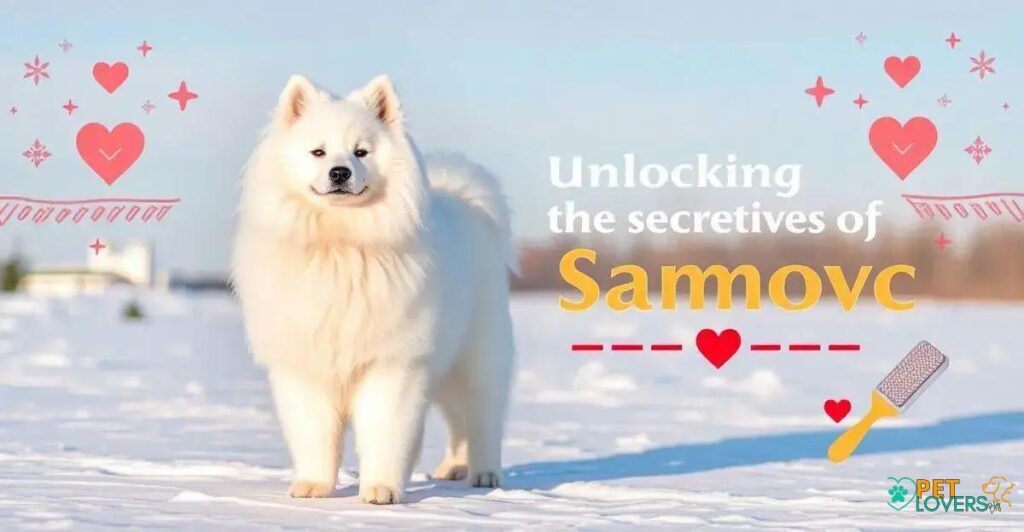The Samoyed is a medium-sized dog breed known for its thick, fluffy coat and friendly, outgoing personality. Originating from Siberia, they were bred to herd reindeer and other livestock, making them excellent family pets and companions today. With proper care, including regular exercise, training, and grooming, Samoyeds can thrive and remain happy and healthy.
The Samoyed, with its fluffy white coat and piercing blue eyes, is a breed that has captured the hearts of many dog lovers.
But beyond its adorable appearance, the Samoyed is a breed with a rich history and unique characteristics.
In this comprehensive guide, we’ll delve into the world of the Samoyed, exploring its origins, physical features, temperament, grooming needs, and more.
Whether you’re a seasoned dog owner or just considering bringing a Samoyed into your family, this article is designed to provide you with a thorough understanding of this beloved breed.
Understanding the Samoyed’s Origins
The Samoyed breed originated in Siberia, where it was used as a herding dog to manage reindeer and other livestock. The breed’s history dates back to the 1600s, when it was highly valued by the Chukchi people for its intelligence, loyalty, and ability to thrive in harsh Arctic conditions.
Over time, the Samoyed was introduced to other parts of the world, where it became a popular companion dog due to its friendly, outgoing nature.
Today, the Samoyed is a beloved breed worldwide, prized for its unique appearance and loving personality.
Physical Characteristics of the Samoyed
The Samoyed is a medium-sized dog breed with a distinctive appearance. Adult Samoyeds typically weigh between 45-65 pounds and stand between 19-23 inches tall at the shoulder. They have a thick, fluffy coat that is usually white, but can also come in a variety of cream, gold, and silver colors. Their coat is one of their most distinctive features, with a thick undercoat and a longer, guard hair on top.
The Samoyed’s ears are triangular and erect, and their eyes are almond-shaped and range in color from blue to brown. Their tail is long and plume-like, and is often carried over their back.
Samoyed Temperament and Personality
The Samoyed is known for its friendly, outgoing personality, which makes it a popular breed as both a family pet and a working dog.
They are highly social dogs that thrive on human interaction and attention, and they are often described as ‘velcro dogs’ because they love to be close to their owners.
Samoyeds are also highly intelligent and trainable, which makes them well-suited for a variety of dog sports and activities.
However, they can be strong-willed and independent at times, which requires consistent training and socialization from an early age.
With proper care and attention, Samoyeds can make wonderful companions for active families or individuals who are looking for a loyal and loving pet.
Samoyed Grooming and Health
The Samoyed’s thick, fluffy coat requires regular grooming to prevent matting and tangling. Daily brushing is essential, especially during shedding season, to remove dead hair and prevent skin irritation.
Additionally, regular bathing and nail trimming are necessary to keep the dog clean and well-groomed. Samoyeds are also prone to certain health issues, such as hip dysplasia and patellar luxation, which can be managed with regular veterinary care and a healthy diet.
It’s also important to monitor their teeth and eyes for signs of disease, and to provide regular exercise and mental stimulation to keep them happy and healthy.
Caring for Your Samoyed
Caring for a Samoyed requires a commitment to providing regular exercise, training, and attention. Samoyeds are high-energy dogs that need daily walks and playtime to keep them happy and healthy.
They also require regular training sessions to teach them basic obedience commands and to address any behavioral issues. In addition to exercise and training, Samoyeds need regular grooming to prevent matting and tangling of their thick coat.
They also need regular veterinary check-ups to monitor their health and address any potential health issues. With proper care and attention, Samoyeds can thrive as beloved family pets and companions.
Conclusion: The Joy of Owning a Samoyed
From their origins in Siberia to their current status as beloved family pets, Samoyeds are a unique and fascinating breed. With their friendly, outgoing personalities and their beautiful, fluffy coats, it’s no wonder why so many people are falling in love with this breed.
Whether you’re a seasoned dog owner or a first-time pet owner, a Samoyed can bring joy and companionship into your life. With proper care and attention, Samoyeds can thrive and become a beloved member of your family.
Remember to research and understand the needs of a Samoyed before bringing one home, and to provide them with regular exercise, training, and attention. With patience, love, and care, a Samoyed can be a wonderful addition to your life.
FAQ – Frequently Asked Questions about Samoyeds
What is the average lifespan of a Samoyed?
The average lifespan of a Samoyed is 12-15 years.
How much exercise do Samoyeds need?
Samoyeds require daily walks and playtime to keep them happy and healthy.
Are Samoyeds good with children?
Yes, Samoyeds are known for being gentle and patient with children.
Do Samoyeds shed a lot?
Samoyeds have a thick, fluffy coat that sheds heavily, especially during shedding season.
Are Samoyeds prone to any health issues?
Samoyeds are prone to certain health issues, such as hip dysplasia and patellar luxation.
Can I leave my Samoyed alone for long periods of time?
Samoyeds are social dogs that thrive on human interaction and attention, so it’s not recommended to leave them alone for long periods of time.
How much grooming do Samoyeds require?
Samoyeds require regular grooming to prevent matting and tangling of their coat, including daily brushing and regular baths.

